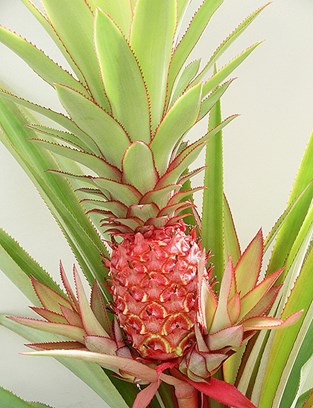Pineapples: Preservation and Potential
Starting around 1898, key advances in production and processing methods—built around the superstar variety Smooth Cayenne—positioned Hawaii as a world leader in exports of canned pineapple.
Although the state no longer holds that title, Hawaii today remains home to one of the world’s largest and most genetically diverse collections of pineapple—the world’s third most popular tropical fruit behind banana and mango. The Agricultural Research Service (ARS) manages the collection on 33 acres of land in Hilo, Hawaii, as part of the National Clonal Germplasm Repository for Tropical Fruit and Nut Crops. All told, 186 different kinds of wild and cultivated pineapple are kept there as both live potted plants in greenhouses and as tissue cultures in test tubes.
“The ARS collection represents a treasure of genetic resources for the identification and improvement of important traits in commercial pineapples as well as for research to understand the basic biology and evolution of different processes in plants,” says horticulturist Tracie Matsumoto, who leads ARS’s Tropical Plant Genetic Resources and Disease Research Unit in Hilo.
|
|
The unit, together with the University of Hawaii at Manoa, acquired the collection in 1986 as a legacy of the defunct Pineapple Research Institute in Hawaii, whose breeding and selection program gave rise to such notable varieties as MD-2.
The collection includes both big-name and little-known pineapples. Some, like MD-2 or Smooth Cayenne, are industry leaders, prized for their fresh fruit or canning quality. Others are more obscure, though not to be overlooked.
An example is Saigon Red, a miniature pineapple brought to Hawaii from Vietnam in 1938. It’s too tart to eat. But the variety’s compact size, red-skinned fruit and long, shapely leaves make it a candidate for landscape plantings or indoor use as a decorative plant.
“Although its fruit is small, Saigon Red may have important agricultural traits that have yet to be discovered,” says Matsumoto. Cross-breeding it with a variety whose fruit is larger and tastier could also prove interesting, she ventures, potentially ushering in specialty pineapples with novel colors or additional nutrients to complement their flavors.
Ensuring the good health and availability of the Hilo collection—which numbers about 400 potted plants and hundreds more tissue-culture specimens—can be labor intensive. So too can cataloguing the accessions and checking them for certain traits, like low acidity (for fresh-market varieties) or “naturally differentiated flowering,” which can result in smaller, lower quality fruit. With traditional methods, checking for such traits would first require growing the pineapple plant to maturity, a process that can take 18 months to 2 years.
Now, new tools called “molecular markers” shorten the process to just a few days. The markers do this by flagging the presence of the gene or genes for traits of interest in the pineapple plant’s DNA. Also, the approach can be used on small tissue samples—such as from seedlings—rather than on full-grown plants, and that saves time, money, and resources.
The markers are useful on other fronts as well. “Markers enable us to look at the evolution of pineapples and their diversity across species and varieties,” says Matsumoto. They’re also helping to weed out duplicates in the collection and clarifying assumptions about pineapple’s four major botanical groupings.
Just as refinements in pineapple canning, coring, and peeling made Hawaii an early world leader in exports, so too is the state on the cusp of technology today to mine the fruit crop’s untapped genetic potential, with benefits to growers and consumers across the globe.—By Jan Suszkiw, ARS Office of Communications.
Key Facts
- Pineapple is the third-most popular tropical fruit in the world.
- Hawaii is home to ARS’s world-class collection of 186 pineapple types.
- The collection helps researchers identify and improve pineapple traits.
Full Story








